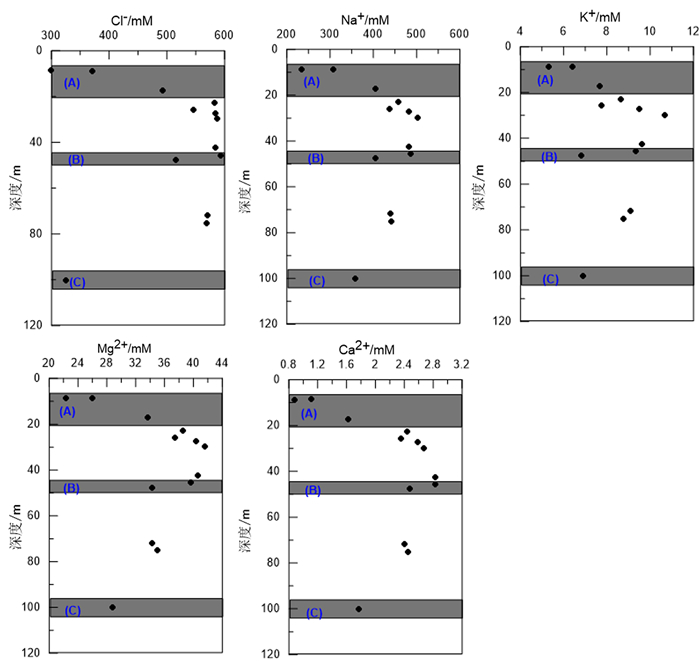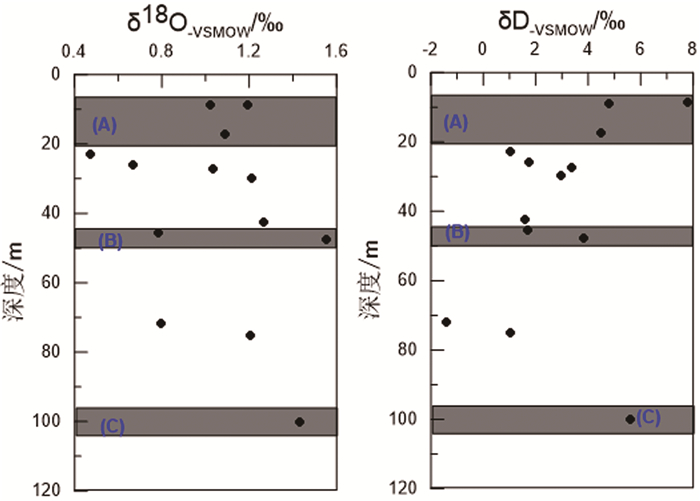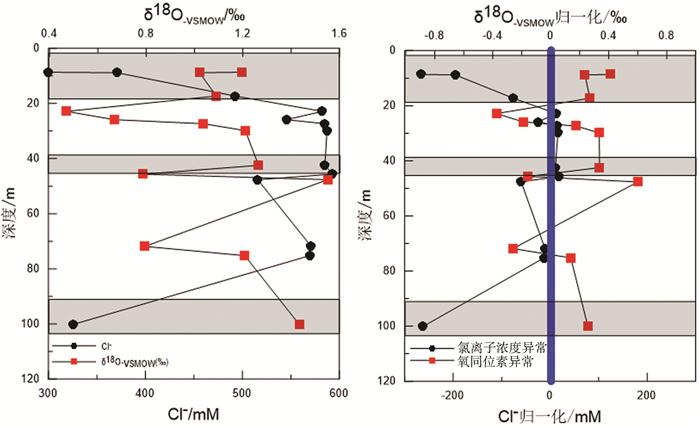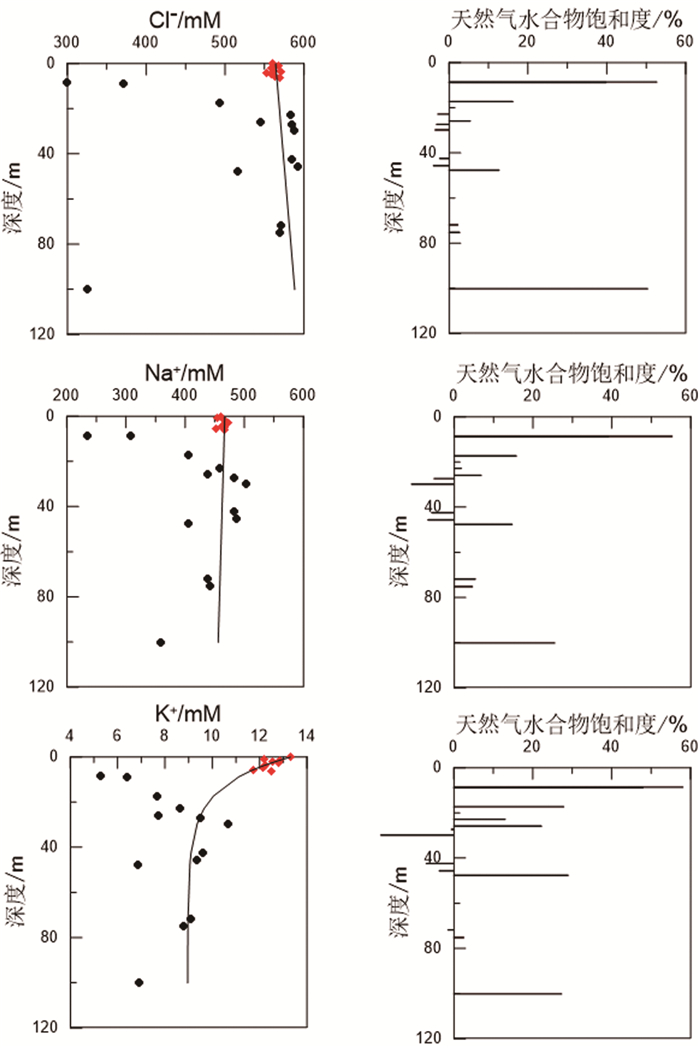Geochemistry of sediment pore water from Well GMGS2-09 in the southeastern Pearl River Mouth Basin, South China Sea: An indication of gas hydrate occurrence
-
摘要: 沉积物孔隙水地球化学是天然气水合物勘探与研究的重要手段。为了探究珠江口盆地东南海域GMGS2-09钻孔的沉积物孔隙水地球化学特征及其对埋藏的天然气水合物的指示意义,我们在前人的研究和认知基础上,通过测试该钻孔沉积物孔隙水的氯离子含量、氢氧同位素和阳离子组成来识别天然气水合物的赋存层位。结果表明GMGS2-09钻孔在9~17、47以及100m处存在氯离子浓度的负异常耦合氧同位素的正异常,指示相应的天然气水合物赋存,其中9~17m层位指示结果与实际取样情况完全一致。此外,采用基于水合物晶格的排盐机理推导的经验公式计算显示水合物饱和度在浅表层(17m)最高约为50%,中间以及底层约为20%。Abstract: Geochemistry of pore water of marine sediments playes an important role in gas hydrate research. In order to detect the gas hydrater-bearing layers, geochemical characteristics and their implications for buried gas hydrates are studied with pore water collected from the Site GMGS2-09 in the southeastern part of the Pearl River Mouth Basin. Cations, anions, hydrogen and oxygen isotopic compositions are analyzed and studied upon previous researches. Chloride anomalies coupled with increased δ18O in pore water are observed at the depths of 9~17 meter, in which gas hydrate is recovered, 47 meter and 100 meter, which may indicate the presences of gas hydrate-bearing layers. Besides, gas hydrate saturation calculated indicates that it is 50% in depth of 17 m, and about 20% in depth of 47 m and 100 m.
-
Keywords:
- gas hydrate /
- pore water /
- geochemistry /
- Pearl River Mouth Basin
-
-
-
[1] Kvenvolden K A. Gas hydrates-geological perspective and global change[J]. Reviews of Geophysics, 1993, 31(2): 173-173. doi: 10.1029/93RG00268
[2] Hesse R. Pore water anomalies of submarine gas-hydrate zones as tool to assess hydrate abundance and distribution in the subsurface: What have we learned in the past decade?[J]. Earth-Science Reviews, 2003, 61(1): 149-179. http://www.sciencedirect.com/science/article/pii/S0012825202001174
[3] Boswell R, Collett T S. Current perspectives on gas hydrate resources[J]. Energy and Environmental Science, 2011, 4(4): 1206-1215. doi: 10.1039/C0EE00203H
[4] Chong Z R, Yang S H B, Ba P, et al. Review of natural gas hydrates as an energy resource: Prospects and challenges[J]. Applied Energy, 2016, 162: 1633-1652. doi: 10.1016/j.apenergy.2014.12.061
[5] Mitchell J F. The "greenhouse" effect and climate change[J]. Reviews of Geophysics, 1989, 27(1): 115-139. http://d.old.wanfangdata.com.cn/OAPaper/oai_doaj-articles_733ecfb1f71e310b64f2e409cb5d33cc
[6] Ruppel C. Methane hydrates and contemporary climate change[J]. Nature Education Knowledge, 2011, 3(10): 29. http://d.old.wanfangdata.com.cn/NSTLQK/NSTL_QKJJ029384431/
[7] Wallmann K J, Dallimore S, Biastoch A, et al. Assessment of the Sensitivity and Response of Methane Gas Hydrate to Global Climate Change[J]. New Phytologist, 2014, 191(2): 376-390.
[8] Brown P J. Sanders R, McDonagh E, et al. Impacts and effects of ocean warming on carbon management including methane hydrates[R]. Explaining ocean warming: Causes, scale, effects and consequences, 2016, IUCN: 373-388.
[9] Borowski W S, Paull C K, Ussler W. Marine pore-water sulfate profiles indicate in situ methane flux from underlying gas hydrate[J]. Geology, 1996, 24(7): 655-658. doi: 10.1130/0091-7613(1996)024<0655:MPWSPI>2.3.CO;2
[10] Borowski W S, Paull C K, Ussler W. Global and local variations of interstitial sulfate gradients in deep-water, continental margin sediments: Sensitivity to underlying methane and gas hydrates[J]. Marine Geology, 1999, 159(1): 131-154. https://www.onacademic.com/detail/journal_1000034148296210_469e.html
[11] Milkov A V, Claypool G E, Lee Y J, et al. In situ methane concentrations at Hydrate Ridge, offshore Oregon: New constraints on the global gas hydrate inventory from an active margin[J]. Geology, 2003, 31(10): 833-836. doi: 10.1130/G19689.1
[12] Torres M, Wallmann K, Tréhu A, et al. Gas hydrate growth, methane transport, and chloride enrichment at the southern summit of Hydrate Ridge, Cascadia margin off Oregon[J]. Earth and Planetary Science Letters, 2004, 226(1): 225-241. doi: 10.1016-j.epsl.2005.05.044/
[13] Tomaru H, Torres M E, Matsumoto R, et al. Effect of massive gas hydrate formation on the water isotopic fractionation of the gas hydrate system at Hydrate Ridge, Cascadia margin, offshore Oregon[J]. Geochemistry Geophysics Geosystems, 2006, 7(10). http://www.wanfangdata.com.cn/details/detail.do?_type=perio&id=10.1029/2005GC001207
[14] Kim J H, Torres M E, Hong W L, et al. Pore fluid chemistry from the second gas hydrate drilling expedition in the Ulleung Basin (UBGH2): Source, mechanisms and consequences of fluid freshening in the central part of the Ulleung Basin, East Sea[J]. Marine and Petroleum Geology, 2013, 47(47): 99-112. http://www.sciencedirect.com/science/article/pii/S0264817213000056
[15] 杨涛, 叶鸿, 赖亦君.南海北部陆坡天然气水合物的沉积物孔隙水地球化学研究进展[J].海洋地质与第四纪地质, 2017, 37(5):48-58. http://hydz.chinajournal.net.cn/WKD/WebPublication/paperDigest.aspx?paperID=86191583-ebd6-4ca4-bf79-024ff81d7dc7 YANG Tao, YE Hong, LAI Yijun. Pore water geochemistry of the gas hydrate bearing zone on northern slope of the South China Sea[J]. Marine Geology and Quaternary Geology, 2017, 37(5):48-58. http://hydz.chinajournal.net.cn/WKD/WebPublication/paperDigest.aspx?paperID=86191583-ebd6-4ca4-bf79-024ff81d7dc7
[16] Jiang S Y, Yang T, Ge L, et al. Geochemistry of pore waters from the Xisha Trough, northern South China Sea and their implications for gas hydrates[J]. Journal of Oceanography, 2008, 64(3): 459-470. doi: 10.1007/s10872-008-0039-8
[17] Wu N Y, Zhang H Q, Yang S X et al. Gas hydrate system of Shenhu area, northern South China Sea: geochemical results[J]. Journal of Geological Research, 2011, 2011:370298.
[18] Zhang G X, Liang J Q, Lu J A, et al. Geological features, controlling factors and potential prospects of the gas hydrate occurrence in the east part of the Pearl River Mouth Basin, South China Sea[J]. Marine and Petroleum Geology, 2015, 67: 356-367. doi: 10.1016/j.marpetgeo.2015.05.021
[19] Luo M, Chen L, Wang S, et al. Pockmark activity inferred from pore water geochemistry in shallow sediments of the pockmark field in southwestern Xisha Uplift, northwestern South China Sea[J]. Marine and Petroleum Geology, 2013, 48: 247-259. doi: 10.1016/j.marpetgeo.2013.08.018
[20] Hu Y, Feng D, Liang Q, et al. Impact of anaerobic oxidation of methane on the geochemical cycle of redox-sensitive elements at cold-seep sites of the northern South China Sea[J]. Deep Sea Research Part Ⅱ Topical Studies in Oceanography, 2015, 122: 84-94. doi: 10.1016/j.dsr2.2015.06.012
[21] Ye H, Yang T, Zhu G R, et al. Pore water geochemistry in shallow sediments from the northeastern continental slope of the South China Sea[J]. Marine and Petroleum Geology, 2016, 75: 68-82. doi: 10.1016/j.marpetgeo.2016.03.010
[22] Yang T, Jiang S Y, Yang J H, et al. Dissolved inorganic carbon (DIC) and its carbon isotopic composition in sediment pore waters from the Shenhu area, northern South China Sea[J]. Journal of Oceanography, 2008, 64(2): 303-310. doi: 10.1007/s10872-008-0024-2
[23] Yang T, Jiang S Y, Ge L, et al. Geochemical characteristics of pore water in shallow sediments from Shenhu area of South China Sea and their significance for gas hydrate occurrence[J]. Chinese Science Bulletin, 2010, 55(8): 752-760. doi: 10.1007/s11434-009-0312-2
[24] Cao C, Lei H. Geochemical characteristics of pore water in shallow sediments from north continental slope of South China Sea and their significance for natural gas hydrate occurrence[M]. Procedia Environmental Sciences, 2012, 12: 1017-1023.
[25] Wu L S, Yang S X, Liang J Q, et al. Variations of pore water sulfate gradients in sediments as indicator for underlying gas hydrate in Shenhu Area, the South China Sea[J]. Science China Earth Sciences, 2013, 56(4): 530-540. doi: 10.1007/s11430-012-4545-6
[26] Luo M, Chen L, Tong H, et al. Gas hydrate occurrence inferred from dissolved Cl-concentration and δ18O values of pore water and dissolved sulfate in the shallow sediments of the pockmark filed in the southwestern Xisha uplift, northern South China Sea[J]. Energies, 2014, 7(6): 3886-3899. doi: 10.3390/en7063886
[27] Feng D, Cheng M, Kiel S, et al. Using Bathymodiolus tissue stable carbon, nitrogen and sulfur isotopes to infer biogeochemical process at a cold seep in the South China Sea[J]. Deep-Sea Research Part Ⅰ-Oceanographic Research Papers, 2015, 104: 52-59. doi: 10.1016/j.dsr.2015.06.011
[28] Lin Z, Sun X, Lu Y, et al. Stable isotope patterns of coexisting pyrite and gypsum indicating variable methane flow at a seep site of the Shenhu area, South China Sea[J]. Journal of Asian Earth Sciences, 2016, 123: 213-223. doi: 10.1016/j.jseaes.2016.04.007
[29] 龚跃华, 杨胜雄, 王宏斌, 等.南海北部神狐海域天然气水合物成藏特征[J].现代地质, 2009, 23(2): 210-216. doi: 10.3969/j.issn.1000-8527.2009.02.003 GONG Yuehua, YANG Shengxiong, WANG Hongbin, et al. Gas hydrate reservoir characteristics of Shenhu Area, north slope of the South China Sea[J]. Geoscience, 2009, 23(2): 210-216. doi: 10.3969/j.issn.1000-8527.2009.02.003
[30] 姚伯初.南海的天然气水合物矿藏[J].热带海洋学报, 2001, 20(2): 20-28. doi: 10.3969/j.issn.1009-5470.2001.02.004 YAO Bochu. The gas hydrate in the South China Sea[J]. J. Trop. Oceanogr, 2001, 20(2): 20-28. doi: 10.3969/j.issn.1009-5470.2001.02.004
[31] 陈多福, 李绪宣, 夏斌, 南海琼东南盆地天然气水合物稳定域分布特征及资源预测[J].地球物理学报, 2004, 47(3): 483-489. doi: 10.3321/j.issn:0001-5733.2004.03.018 CHEN Duofu, LI Xuxuan. XIA Bin. Distribution of gas hydrate stable zones and resource prediction in the Qiongdongnan Basin of the South China Sea[J]. Chinese Journal Geophysics, 2004, 47(3): 483-489. doi: 10.3321/j.issn:0001-5733.2004.03.018
[32] 姚伯初.南海天然气水合物的形成和分布[J].海洋地质与第四纪地质. 2005, 25(2): 81-90. http://hydz.chinajournal.net.cn/WKD/WebPublication/paperDigest.aspx?paperID=a561892b-f645-4747-bdd5-c9abe883d163 YAO Bochu. The forming condition and distribution characteristics of the gas hydrate in the South China Sea[J]. Marine Geology and Quaternary Geology, 2005, 25(2): 81-90. http://hydz.chinajournal.net.cn/WKD/WebPublication/paperDigest.aspx?paperID=a561892b-f645-4747-bdd5-c9abe883d163
[33] Jiang S Y, Yang T, Ge L, et al. Geochemical anomaly of pore waters and implications for gas hydrate occurrence in the South China Sea[R]//Proceedings of the 6th International Conference on Gas Hydrates (ICGH 2008), 2008.
[34] Zhang G X, Chen F, Yang S X, et al. Accumulation and exploration of gas hydrate in deep-sea sediments of northern South China Sea[J]. Chinese Journal of Oceanology and Limnology, 2012, 30: 876-888. doi: 10.1007/s00343-012-1313-6
[35] Yang S X, Ming Z, Liang J Q, et al. Preliminary results of China's third gas hydrate drilling expedition: A critical step from discovery to development in the South China Sea[J]. Fire in the Ice, 2015, 15(2): 1-5.
[36] Liang Q Y, Hu Y, Feng D, et al. Authigenic carbonates from newly discovered active cold seeps on the northwestern slope of the South China Sea: Constraints on fluid sources, formation environments, and seepage dynamics[J]. Deep-sea Research Part Ⅰ-Oceanographic Research Papers, 2017, 124: 31-41. doi: 10.1016/j.dsr.2017.04.015
[37] 吴能友, 黄丽, 胡高伟, 等.海域天然气水合物开采的地质控制因素和科学挑战[J].海洋地质与第四纪地质, 2017, 37(5):1-11. http://hydz.chinajournal.net.cn/WKD/WebPublication/paperDigest.aspx?paperID=7ac0922f-09a0-4694-a851-841b8fc0bf7f WU Nengyou, HUANG Li, HU Gaowei, et al. Geological controlling factors and scientific challenges for offshore gas hydrate exploration[J]. Marine Geology and Quaternary Geology, 2017, 37(5):1-11. http://hydz.chinajournal.net.cn/WKD/WebPublication/paperDigest.aspx?paperID=7ac0922f-09a0-4694-a851-841b8fc0bf7f
[38] 张光学, 梁金强, 陆敬安, 等.南海东北部陆坡天然气水合物藏特征[J].天然气工业, 2014, 34(11): 1-10. doi: 10.3787/j.issn.1000-0976.2014.11.001 ZHANG Guangxue, LIANG Jinqiang, LU Jingan, et al. Characteristics of natural gas hydrate reservoirs on the northeastern slope of the South China Sea[J]. Natural Gas Industry, 2014, 34(11): 1-10. doi: 10.3787/j.issn.1000-0976.2014.11.001
[39] Zhang G X, Yang S X, Zhang M, et al. GMGS2 Expedition Investigates Rich and Complex Gas Hydrate Environment in the South China Sea[J]. Fire in the Ice, 2014, 14(1).
[40] 杨涛, 薛紫晨, 杨竞红, 等.南海北部地区海洋沉积物中孔隙水的氢、氧同位素组成特征[J].地球学报, 2003, 24(6):511-514. doi: 10.3321/j.issn:1006-3021.2003.06.005 YANG Tao, XUE Zichen, YANG Jinghong, et al. Oxygen and Hydrogen Isotopic Compositions of Pore Water from Marine Sediments in the Northern South China Sea[J]. Acta Geosicientia Sinica, 2003, 24(6): 511-514. doi: 10.3321/j.issn:1006-3021.2003.06.005
[41] Kastner M, Elderfield H, Martin J B, et al. In Diagenesis and interstitial-water chemistry at the Peruvian continental margin—major constituents and strontium isotopes[C]// Proceedings of the Ocean Drilling Program, Scientific Results, 1990: 413-440.
[42] Ayalon A, Longstaffe F J. Oxygen isotope studies of diagenesis and pore-water evolution in the western canada sedimentary basin: evidence from the upper cretaceous basal belly river sandstone, alberta[J]. Journal of Sedimentary Research, 1988, 58(3): 489-505.
[43] Burns S J. Can diagenetic precipitation of carbonate nodules affect pore-water oxygen isotope ratios?[J]. Journal of Sedimentary Research, 1998, 68(1): 302-305. http://www.researchgate.net/publication/250082522_Can_Diagenetic_Precipitation_of_Carbonate_Nodules_Affect_Pore-Water_Oxygen_Isotope_Ratios
[44] Matsumoto R, Borowski W S, Matsumoto R, et al. Gas hydrate estimates from newly determined oxygen isotopic fractionation (α(GH-IW)) and δ18O anomalies of the interstitial waters: Leg 164, Blake Ridge[C]// Proceedings of the Ocean Drilling Program Scientific Results, 2000, 164: 59-66.
[45] Malinverno A, Kastner M, Torres M E, et al. Gas hydrate occurrence from pore water chlorinity and downhole logs in a transect across the northern Cascadia margin (Integrated Ocean Drilling Program Expedition 311)[J]. Journal of Geophysical Research Solid Earth, 2008, 113(B8). doi: 10.1029-2008JB005702/



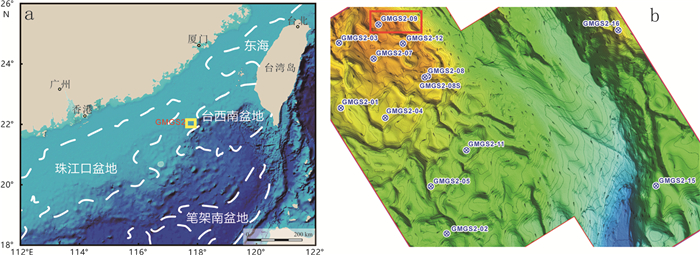
 下载:
下载:
